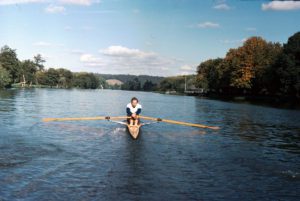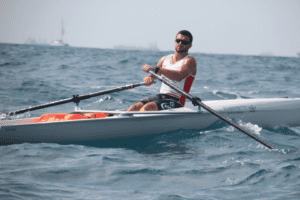Advertisements
We got a reader question that we can’t answer….isn’t that great?
Does anybody use/recommend the use of rope skipping as a means of improving co-ordination and core stability?. I mean high quality

speed skipping as boxers do.
Any Rowperfect readers who can answer this, please comment below. Would love to hear some ideas.
Advertisements








This Post Has 7 Comments
Rope jumping expends a similar amount of energy as rowing, however the motor patterns are different. Therefore, you would experience general conditioning benefits from rope jumping, though it is unlikely to directly transfer to rowing improvement. You could do rope jumping to develop overall cardiovascular fitness that does not stress the muscles and joints in the same fashion as rowing, so it would be a great cross-training or recovery modality. It might also develop coordination and core stability, however these adaptations would be specific to rope jumping and would not be a complete substitute to on-the-water or erg training.
Training can generally be broken down into two phases: general and specific. General training are forms of exercise that create whole-body stimulus that improve overall strength and endurance. Rope jumping, jogging, cycling, and weightlifting can be thought of general training (for rowers), as you experience benefits that help with your sport/activity (in this case rowing) by improving your overall cardiovascular fitness, strength, power, muscular endurance and motor coordination. Specific training mimics your sport/activity closely (or direct practice) and this training not only improves specific muscular and metabolic systems, but also improves the sport-specific motor patterns needed for high-level performance. For example, cycling and weightlifting can improve strength and endurance in muscle groups that are used during rowing so your potential increases, however actual rowing practice is needed to develop specific adaptations to strength, endurance and motor performance to make you a faster rower.
Long story short, rope jumping is a great general form of conditioning for cross-training, circuit training, warm up, or recovery. However,the different motor patterns (specifically the plane of motion and the angles of the joints and muscle groups active during the movement), there will be little transfer into improving rowing performance.
Kent
Thanks very much for this – really clear explanation!
Rebecca
You are welcome, I’m glad I could help.
Kent
Kent, Thank you very much for that. We are trying to give 12-17 year olds, from four different schools in four different towns, something interesting to do during the week. We are lucky, or unlucky, depends how you look at it, to have some very athletic kids this year who do a lot of other sports, hockey, tennis, rugby etc.
Hill walking, cycling, skipping, hula hoops, body circuits, whilst not sport specific, keep them flexible and exercise the trunk muscles depending upon how diligent they are.
Thanks again
Ian
You are welcome Ian. It sounds like you have a great program, and having the kids do a variety of activities is very useful in terms developing general conditioning and coordination but also minimizing burnout. We want people to be active for a lifetime and enjoy the training, so while specific training is necessary for optimal performance, spending time doing other things really does help distribute physical and mental stress so our careers are extended.
Thanks, and well done letting the kids play!!
Kent
Hi I read this and thought it was really interesting. I skip regularly as part of a circuit training program I do, so instead of using short sprints/intervals as one of the stations I incorporate skipping (especially if you are short on space). Its a brilliant form of CV trg and there is much research to back up the inclusion of quick skipping in circuit training that can add even more benefits (just like the inclusion of shuttle sprints etc). But has it done anything for my sculling? I would agree with Kent and say its a limited benefit, there is no doubt that skipping helps me get fitter, I’ve lost weight, the impact on joints etc is less and my core has improved as has my coordination, but that’s about it. The joint impact is a key bit I laot older now and my body needs to do low impact stuff sometimes or it starts to complain! Now when I first started I found it really difficult to get a rhythm going but to get the most out of it you have to solve some really simple technical issues that people learning skipping for the first time fall into. There are some great clips on YOUTUBE that show some of the mistakes people commonly end up doing. Solve them and you suddenly have an alternative and really enjoyable form of exercise. Its great fun and I really get something out of it! Good luck.
We tried rope skipping at our local ARC; lo and behold, it boosted the endorphins and tired us out in one swift session! More practise methinks… Anyway, skipping has been recommended around the local ARA, due to it’s simplicity. Just grab a rope and a spare ten minutes a day, and get the cardiovascular system going.